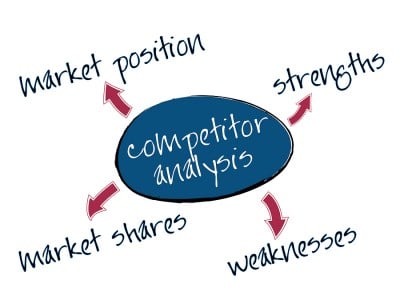 You never see people talk about competitors on social networks, and on marketing blogs.
You never see people talk about competitors on social networks, and on marketing blogs.
It’s the ultimate taboo topic.
Get behind closed doors and that changes quickly. Marketers obsess about their competitors, messaging, and corresponding market share.
That’s why we talk about competitors a great deal in Marketing in the Round.
Some believe they should focus on their own core actions and grow a bigger pie for the whole industry, and others see competitors as all-out enemies. Whichever side you’re on, it’s helpful to have context and evaluate your competitors’ successes and failures in the marketplace. Here are some tips to help you.
Monitor the Competition
There are some marketing actions all companies have to take to become viable. Almost all of them end up online. These include publishing a Web site; creating news stories; initiating social media efforts; developing advertisements for print, broadcast, interactive, and/or search; and creating content and publicly available newsletters.
 Analyze your competitors’ marketing—see which efforts work well, and understand why stakeholders like them: What is their primary messaging? Why does or doesn’t it work? How do people respond to the company’s overtures online? Is word of mouth positive or negative? Why?
Analyze your competitors’ marketing—see which efforts work well, and understand why stakeholders like them: What is their primary messaging? Why does or doesn’t it work? How do people respond to the company’s overtures online? Is word of mouth positive or negative? Why?
Which products or services compete directly against your own? What are the price points? Are there public partnerships that help distribute their offerings? How loyal are their customers?
If you are competing against U.S. publicly traded companies, look at their 10-K and 10-Q SEC filings on EDGAR. Such companies are required by law to inform investors about prospects and threats—a great way to get intelligence about your competitors’ actions and about general market risks.
Set up a search for them in your Twitter stream so you can see what their customers are saying about them…and how they’re responding (if at all).
Record this analysis in an easy-to-access document, perhaps a spreadsheet on a shared workspace if you’re dealing with more than a handful of competitors. Organize your competition by threat level—some are more successful than others, some will be head-to-head rivals in sales situations.
Ranking the players in the total marketplace will allow your marketing team to focus energy on combating the players that pose the biggest threats to your sales and viability.
Competitive focus allows your marketing round to see what kinds of offerings and products will meet consumer demand, what it can do to be different, and how it can capitalize on weaknesses or gaps.
Your effort should be different from the competition in tone, and adaptable in form and price by customers who will clearly use it. Good marketing positions a product or service into the market that’s almost undefeatable. It’s about creating separation and standing out. Otherwise it’s a commoditized battle for market share, and that often turns into lower margins.
Competitive Response
If marketers do their job well, and their product, service, or solution gets a warm reception, the competition won’t sit and watch while your marketing round takes away market share.
They will act.
Sometimes they refuse to even acknowledge you or the incredible job you’ve done, dwindling into the past. Other times they mimic your offering. Some competitors get angry, and trash, sue, and undercut you at every opportunity.
The toughest competitors go toe-to-toe with you, countering every move you make. The best competitors just leapfrog your offering, bettering it and seize the marketplace.
It’s so important to have monitoring in place, not just for your brand, but also your competition.
A significant percentage of executives find out about a competitor’s move only when it is announced. The ensuing drama can send a company’s marketing team into an unfocused tizzy of overreaction and distract it from its most important focus: customers.
There’s big danger in over-responding to the competition, in focusing on secondary and urgent-feeling goals instead of on the primary objective. Those smaller issues become distractions, and distractions are a hindrance to achieving success.
Your marketing team needs to know when to respond to a competitor’s actions. The scenarios that are most likely to require a response are a new competitive offering or a price cut. In other instances, it’s difficult to know whether working to counteract a competitor is worth the investment or is just a distraction.
Here are some questions to consider:
- Does the competitive response significantly increase the quality of their offering?
- Does it surpass your company’s effort?
- Are you losing customers as a result of the competitive action?
- Are customers actively discussing your competitor on social media?
- Is the competitor getting fleeting attention from the media, or is there sustained marketplace buzz?
- Has the announcement hurt your brand equity?
If you are answering yes to some or all of these questions, you will want to respond. But respond intelligently. Think it through. Fifty-five percent of companies respond with the most obvious action, says McKinsey and Company. You want your response to yield a competitive advantage, not just noise.
How do you handle competition in today’s marketing environment?

